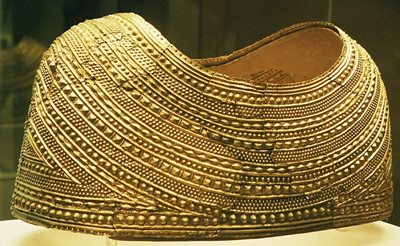It probably had a lining, possibly of leather, which covered the chest and the shoulders of the wearer.
它可能曾有包裹着穿戴者的肩与胸的皮革衬里。
The cape is so fragile, and it would so have restricted the movement of arms and shoulders, that it can only have been very rarely worn.
披肩极为脆弱,同时又极大地限制了肩部与胳膊的活动, 因此应该极少上身。
But there are definite signs of wear, and so it may have been brought out on a number of different ceremonial occasions, perhaps over a long period of time.
但同时上面也有穿戴过的确凿痕迹:比如,披肩的上缘和下缘皆有孔洞,可能用于将其与服装相连。综上所述,它可能只在很长时间举办一次的庆典场合穿着。
But 'who' was wearing it?
但到底是什么样的人在穿?
The cape is too small for a grown man, certainly too small for the mighty warrior of early speculation, and it will fit only a slim small person-a woman or perhaps, more likely, a teenager.
它的尺寸太小,强壮的武士首领应该穿不下,只适合身材痩小的人,如女性或青少年。
Archaeologist Marie-Louise Srensen specialises in the role of the young in these early societies:
考古学家玛丽路易斯斯蒂索伦森强调了早期社会里年轻人的角色:
"We know that in the early Bronze Age very few people would get older than about 25 years. Most children would not get older than 5.
在青铜时代早期,极少有人能活过二十五岁。大部分儿童在五岁前就夭折了。
Many, many women would die in childbirth, and a few would get very old, and these very old people might have had a very special status in the society.
很多女性难产而死,只有少数人能活到很老。那些年龄较大的人在这样的社会里可能享有很特别的地位。
"It's actually difficult to know whether our concept of children applies to this society, where you very quickly became a grown-up member of the community, even if you were only 10 years old, because of the average age of the communities that they lived in.
我们其实很难了解现代的儿童观念是否适用于这样的社会,由于社会的平均年龄较低,即使只有十岁的人也可能很快被当作成年人对待。
That would mean that most people around them were teenagers, there were very few old people in this kind of society."
当时大部分人口的年龄应该都在十几岁。
What this of course challenges, is our perceptions of age and responsibility.
这挑战了我们的年龄和责任概念。













